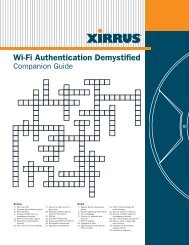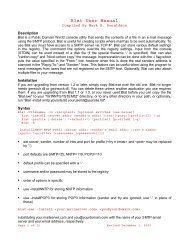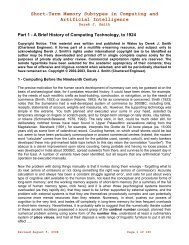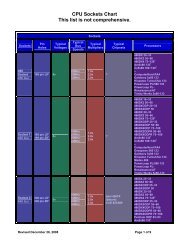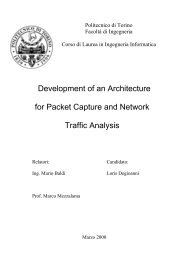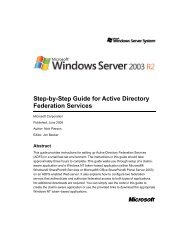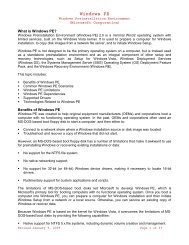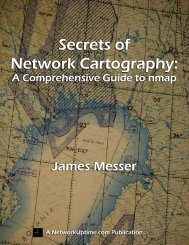Initial Configuration of a Cisco 1200 802.11g WLAN Access Point
Initial Configuration of a Cisco 1200 802.11g WLAN Access Point
Initial Configuration of a Cisco 1200 802.11g WLAN Access Point
Create successful ePaper yourself
Turn your PDF publications into a flip-book with our unique Google optimized e-Paper software.
<strong>Initial</strong> <strong>Configuration</strong> <strong>of</strong> a <strong>Cisco</strong> <strong>1200</strong> <strong>802.11g</strong> <strong>WLAN</strong><br />
<strong>Access</strong> <strong>Point</strong><br />
Michael J. Martin<br />
Our router expert continues his series on building a secure wireless LAN with a Linux base. We've<br />
already covered network segmenting with virtual LANs (VLANs) and the 802.1Q standard, as well as<br />
supporting 802.1Q interfaces on Linux and <strong>Cisco</strong> IOS. Today we will show how to utilize a single<br />
<strong>Cisco</strong> <strong>1200</strong> series access point (AP) to provide access to three different IP network segments using<br />
VLANs and multiple service set identifiers (MSSIDs).<br />
The above diagram illustrates the VLAN/MSSID configuration we will cover in this article. In this<br />
configuration we'll provide access to three IP network segments, supporting three different security<br />
policies:<br />
� WiFi-Protected <strong>Access</strong> (WPA)<br />
� Wireless Equivalency Protocol (WEP), the original admission control and data security standard<br />
developed for wireless access<br />
� OPEN/IP security (IPsec) which leaves the wireless segment open to any client, but requires the<br />
use <strong>of</strong> an IPsec client to access any real data<br />
Revised January 18, 2006 Page 1 <strong>of</strong> 5
<strong>Initial</strong> <strong>Configuration</strong> <strong>of</strong> a <strong>Cisco</strong> <strong>1200</strong> <strong>802.11g</strong> <strong>WLAN</strong><br />
<strong>Access</strong> <strong>Point</strong><br />
Michael J. Martin<br />
The configuration <strong>of</strong> these security policies is the subject <strong>of</strong> future articles. VLAN and MSSID support<br />
is required for this network access model. It will enable the network partitioning needed to provide<br />
unique Layer 3 network access and discreet <strong>WLAN</strong> client authentication policies. Without<br />
VLAN/MSSID support, a <strong>Cisco</strong> AP can only support access to a single Layer 3 network segment and<br />
a single client authentication policy such as WEP or WPA.<br />
A wireless AP configured to provide access to single SSID and LAN segment operates more or less<br />
like an Ethernet hub. Wireless Ethernet uses Carrier Sense Multiple <strong>Access</strong> with Collision Avoidance<br />
(CSMA/CA) to manage client access to the radio frequency to transmit and receive data. Wired<br />
Ethernet devices utilize Carrier Sense Multiple <strong>Access</strong> with Collision Detection (CSMA/CD) to regulate<br />
client access to the wire to transmit and receive data.<br />
The way something appears to be is not always the way it really is. In reality, a wireless AP is a<br />
network bridge. In the context <strong>of</strong> Ethernet, a network bridge is any device that is used to interconnect<br />
two (or more) Ethernet media collision domains in the overall formation <strong>of</strong> a broadcast domain. An<br />
Ethernet collision domain is the physical transmission medium shared by nodes to transmit and<br />
receive Ethernet frames; its access is governed by CSMA/CD or CSMA/CA. A broadcast domain is a<br />
number <strong>of</strong> collision domains interconnected using Ethernet bridges or switches.<br />
A VLANs is the logical, rather than physical, manifestation <strong>of</strong> an Ethernet broadcast domain. Using<br />
VLAN tagging, multiple Ethernet broadcast domains can utilize the same physical link between two<br />
bridges or switches. Using VLANs on an Ethernet switch (which is just a large multi-port bridge with<br />
each port a single collision domain) makes it possible to carve up the switch's port density to support<br />
multiple broadcast domains, each operating independently <strong>of</strong> the other.<br />
What makes the broadcast domain so important is that each <strong>of</strong> the nodes connected to the Ethernet<br />
broadcast domain is considered to be "local" to the others (even when they exist across multiple<br />
switches). That means that all <strong>of</strong> the nodes connected to the broadcast domain can know how to<br />
directly exchange Ethernet frames with each other. Typically, a single IP network subnet is mapped to<br />
a single Ethernet broadcast domain. So the logical partitioning <strong>of</strong> Ethernet broadcast domains by<br />
extension partitions Layer 3 subnets.<br />
Revised January 18, 2006 Page 2 <strong>of</strong> 5
<strong>Initial</strong> <strong>Configuration</strong> <strong>of</strong> a <strong>Cisco</strong> <strong>1200</strong> <strong>802.11g</strong> <strong>WLAN</strong><br />
<strong>Access</strong> <strong>Point</strong><br />
Michael J. Martin<br />
The illustration above depicts the standard implementation <strong>of</strong> Ethernet hubs and an Ethernet switch<br />
using VLANs to support two Layer 2/3 network segments. Each segment at the Layer 2 level operates<br />
independently; a router or routing switch could be used to interconnect the two segments and enable<br />
the exchange <strong>of</strong> data at Layer 3. This exact same configuration can be supported using wireless APs:<br />
Each AP and each hub operates as a collision domain and the Ethernet switch "bridges" them<br />
together. Data can be exchanged between the two broadcast domains at Layer 3 using a router or<br />
routing switch.<br />
Here is where it gets a little messy: When you implement VLANs and MSSID support on the <strong>Cisco</strong><br />
<strong>1200</strong> AP, you effectively convert the AP from a standard two-port bridge into a multi-port bridge. Now,<br />
today the term "multi-port bridge" is almost synonymous with "switch." The AP, however, does not<br />
become a wireless switch. In fact, quite the contrary happens. So while MSSIDs do provide the ability<br />
to create unique SSIDs in terms <strong>of</strong> client association limits and authentication schemes and operate<br />
as a "bridged" collision domain, there is still only one radio that utilizes one frequency with the<br />
available bandwidth shared between each <strong>of</strong> the SSIDs. The MSSID virtualizes the radio in much the<br />
same fashion that an 802.1Q trunk port operates. There are a number <strong>of</strong> different networks laying<br />
claim to the port, but in the end each packet is forwarded one at a time.<br />
This kind <strong>of</strong> bandwidth sharing does not present a problem in most cases, because most 802.1Q<br />
trunk ports are configured using Gigabit Ethernet as the interconnection medium. When you do this<br />
with a fixed transmission range radio, you need to keep in mind how radio access works with 802.11.<br />
The radio operates at the lowest client supported speed. So, if you have users on the<br />
OUTER_SPACE SSID operating at 54 Mbps and someone joins the INNER_SPACE SSID at 11<br />
Mbps, everyone will run at 11 Mbps.<br />
Revised January 18, 2006 Page 3 <strong>of</strong> 5
<strong>Initial</strong> <strong>Configuration</strong> <strong>of</strong> a <strong>Cisco</strong> <strong>1200</strong> <strong>802.11g</strong> <strong>WLAN</strong><br />
<strong>Access</strong> <strong>Point</strong><br />
Michael J. Martin<br />
I emphasis this fact because throughout this series on <strong>WLAN</strong>, part <strong>of</strong> the emphasis has been the use<br />
<strong>of</strong> inexpensive APs (such as the Linksys WAP54G) because they are inexpensive and they <strong>of</strong>fer the<br />
same basic security options (i.e., WPA and WEP) as the <strong>Cisco</strong> 1100/<strong>1200</strong> APs. While wireless client<br />
authentication is important, to a large degree the security <strong>of</strong> our configuration is not dependent on any<br />
<strong>of</strong> the enhanced support options that are part <strong>of</strong> the 1100/<strong>1200</strong> series APs. So why are we talking<br />
about the <strong>Cisco</strong> <strong>1200</strong> today? Well, after some recent client experiences, reader feedback (I love<br />
reader feedback) and enhancements to the <strong>Cisco</strong> <strong>1200</strong>'s capabilities such as VLAN/MSSID support, I<br />
thought some attention was due.<br />
Using a <strong>Cisco</strong> <strong>1200</strong> AP instead <strong>of</strong> three Linksys WPA54Gs does provides some advantages in terms<br />
<strong>of</strong> support, manageability (i.e., authentication, authorization and accounting support, command line<br />
interface and standard IOS command support) and better utilization <strong>of</strong> radio spectrum space. I feel<br />
that makes it worth the additional cost for some environments.<br />
There are also a few caveats to supporting the following solution. The first is that the unit must be a<br />
<strong>Cisco</strong> <strong>1200</strong> that has an <strong>802.11g</strong> radio (model # C<strong>1200</strong>-K9W7-M or later). The second is that the unit<br />
must be running <strong>Cisco</strong>'s Internetwork Operating System (IOS). Now, if your <strong>1200</strong>'s radio supports only<br />
802.11b and/or is running the VxWorks OS, you do have options. First, you can purchase an <strong>802.11g</strong><br />
radio upgrade for around $100.00. This is a great option for shops that have existing APs. It is also<br />
possible to upgrade the OS code from VX to IOS. <strong>Cisco</strong> has a process to perform this conversion, but<br />
it is not reversible. Once you go IOS, you can't go back.<br />
The process for upgrading the IOS code on the AP is the same one followed when upgrading the<br />
code on a <strong>Cisco</strong> IOS-based switch: using the
<strong>Initial</strong> <strong>Configuration</strong> <strong>of</strong> a <strong>Cisco</strong> <strong>1200</strong> <strong>802.11g</strong> <strong>WLAN</strong><br />
<strong>Access</strong> <strong>Point</strong><br />
Escape character is '^]'.<br />
User <strong>Access</strong> Verification<br />
Username: <strong>Cisco</strong><br />
Password:<br />
ap&rt;<br />
Michael J. Martin<br />
There is also a default password. I'll give you three guesses…give up? It's "<strong>Cisco</strong>!" Now the sarcasm<br />
you may be sensing is not directed at <strong>Cisco</strong>. The fact is that <strong>Cisco</strong> was insightful enough to predict<br />
that there would be boneheads in the world that would connect an AP to a live network without ever<br />
configuring the unit. These passwords provide a screen door, at best, but at least there is a door. The<br />
message here is: Do not connect any AP to a live network. Next month, we will get into the switch and<br />
AP configuration.<br />
Revised January 18, 2006 Page 5 <strong>of</strong> 5



